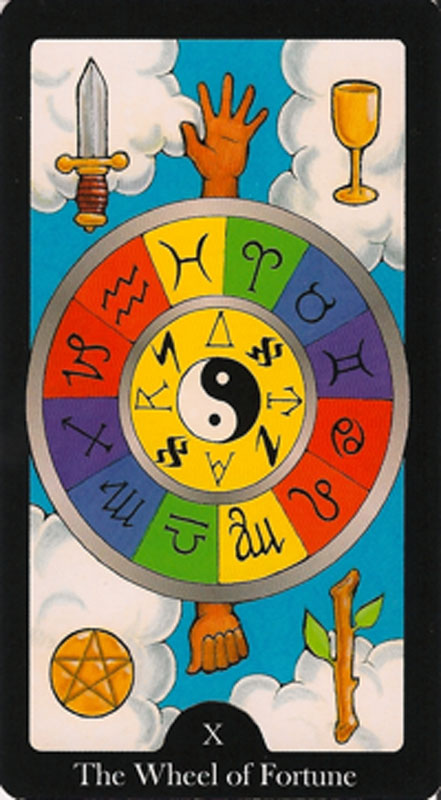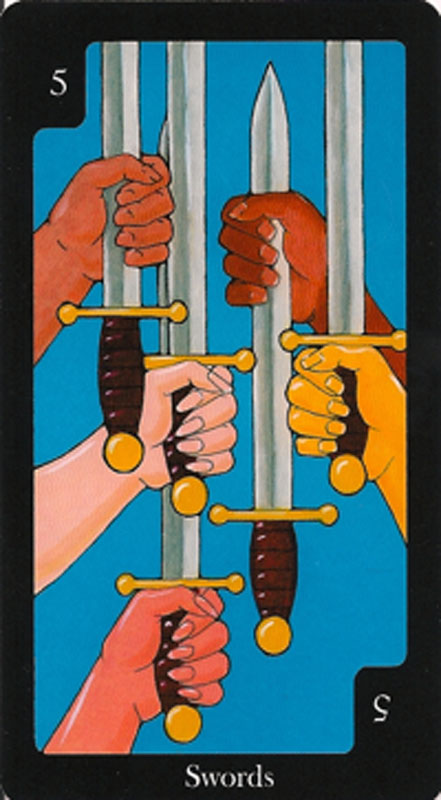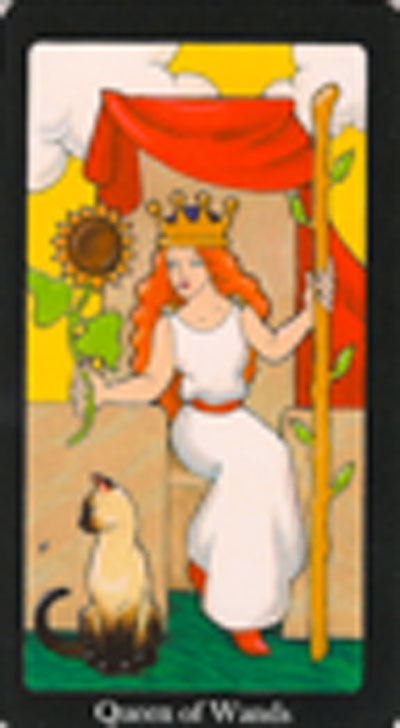
Let’s face it, folks...there are a lot of Rider-Waite-Smith clone decks out there. And there’s a good reason for that: RWS symbology makes up the vast majority of tarot decks on the market today, and many readers and clients identify with it. But when you pick up the Hallmark Tarot deck, you can see and feel almost immediately that there’s definitely something unusual about it.
First, the texture of the cards is unlike anything I’ve experienced. While many of today’s decks feel slippery at first, the Hallmark Tarot doesn’t; it feels a little rougher than other cards and is more flexible for shuffling, which I really liked, since I’m a little less gentle on my cards than other readers. But I didn’t feel as though the cards were less well made than others; quite the contrary. They felt comfortable in my hands right away.
Next, the back of the cards is a dark blue background with five small stars and an image of the Hermit’s lantern bathed in a bright yellow light. Considering the inner wisdom that the tarot is trying to convey, I felt it was a completely appropriate symbol to use, and I liked the simplicity.
Once you turn the cards over, the artwork is rather surprising. The colors are very bright, especially the primary colors and green, which really pop out of each card. This is much more obvious on the Minor Arcana cards, as each suit has a particular single-color background that makes it easily identifiable during a reading. I initially had a little bit of difficulty since the background color of the suits does not match the colors that I associate with each of the four elements. For example, in the Hallmark Tarot the background for the cups suit is green, a color I would associate more with elemental earth (pentacles) than water (cups). But I will admit that having the consistency of the color theme makes working with it easier in the long run.
Another unexpected aspect of the imagery is that the innocence of the images really comes through. All of the cards are hand-drawn, and they tone down the severity of the traditional RWS images nicely. On the Death card, for example, there is very little about the card that one would consider morbid, or scary: A chained figure, likely a female, carrying a sword and holding a key bows down to you from a graveyard as her hair forms the sky. For me this reinforced the image of the “release” that change can bring in a person’s life.
Each of the Major Arcana cards has the traditional numbering system at the bottom of each card just above the names. Hallmark has for the most part retained the names of the majors save for a few changes--VIII is Passion instead of Strength, for example. All of the pips except the Aces have Arabic numbers printed with a black background in the top left and lower right-hand corners of each card. The Aces and the Court cards contain the full titles. All of the card titles are listed in white against a black border so they are readily visible.
While most of the Minor Arcana are copies of the RWS imagery, the main differences are those of omission; Hallmark was definitely going for a simpler, cleaner look than many other clones out there. Most of the imagery has been reduced to showing a single figure on each card, and in some cases, like the Ten of Pentacles, the figures on the card are removed entirely. One of the more conspicuous changes in the pips is the Five of Swords. Hallmark takes out the scenery and people, so the card shows just five swords being held aloft on a plain blue background. The Aces also tend to be a little simpler as well, with the background landscape normally present on the RWS removed, but that stylistic choice doesn’t take away from the power of the cards.
The Wheel of Fortune is one of my favorite cards in the deck. It is very colorful and puts the astrological symbols for each of the twelve signs of the Zodiac on each card. For me it reinforces the idea that time is ever-flowing, and that if we are having difficulty, this too shall pass. In addition, Hallmark replaces the traditional symbols for the four fixed signs (bull, lion, eagle, and water-bearer) with symbols for the four suits of the tarot deck. This change reduces the number of symbols on the card and will resonate with those who may be less experienced with the cards.
The little white--in this case, black--book that comes with this deck also threw me a curve ball. In addition to card interpretations for each of the 78 cards, Kelly Danann, the author of Tarot Magick, provides symbolism interpretation and magickal advice for the Major Arcana cards in the book, clearly noted in purple italicized text. For those who include the tarot in their spell casting it’s a nice addition.
This tarot deck is very suitable for younger tarot readers—almost no nudity (everything is covered) and very few disturbing images to be found here, like on the Ten of Swords. I would not hesitate to give this deck to a teenager learning the tarot. With that said, while the cards are beautiful, the way they are drawn may make seasoned tarot veterans take them less seriously, unfortunate as that may be. Please don’t misunderstand me; I don’t think that as a general rule tarot cards need to be disturbing or scary to be effective. It is possible, however, that older tarot enthusiasts may pass on this deck because it looks like kid stuff or that it seems too cutesy.
Darla Hallmark has done an excellent job of bringing an optimistic outlook to these cards. As such, this is a great deck to use if your client is young, or if you are starting to feel like a “gloom and doom” reader as you read for yourself or others. Magickally speaking, this would be an excellent deck to use to focus on the positive, so it could be used to re-evaluate a person’s life situation in a more beneficial light.
~review by John Marani
Creator: Darla Hallmark, annotated by Kelly Danann
7th House Publishing
$24.95


